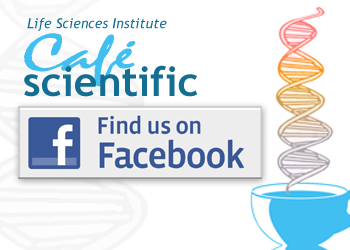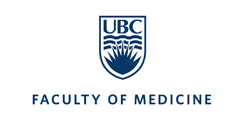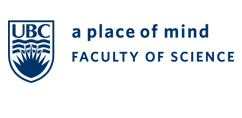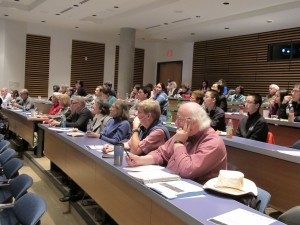 On February 13, 2012, the Life Sciences Institute (LSI) at the University of British Columbia hosted the 9th LSI Café Scientifique. Over 50 interested community members, students and faculty gathered for an informal and participatory dialogue with LSI experts for the second session in the “Seeing Is Believing” series. The particular topic of the session was “Using Fruit Flies to shed light on Health & Disease”.
On February 13, 2012, the Life Sciences Institute (LSI) at the University of British Columbia hosted the 9th LSI Café Scientifique. Over 50 interested community members, students and faculty gathered for an informal and participatory dialogue with LSI experts for the second session in the “Seeing Is Believing” series. The particular topic of the session was “Using Fruit Flies to shed light on Health & Disease”.
The Café featured members of the Cell and Developmental Biology Research Group who use Drosophila melanogaster (fruit fly) as their genetic model organism of choice to understand molecular interactions that occur during nervous system and connective tissue development. The interactive session was presented by Drs. Vanessa Auld, and Michael Gordon, from the department of Zoology and Dr. Guy Tanentzapf from the Department of Cellular and Physiological Sciences.
Dr. Vanessa Auld started the presentation with an overview of the Drosophila model system and why it makes an excellent model to study development and disease progression. As case in points is using this system to understanding how the nervous system develops and functions. The Drosophila nervous system is far simpler and with the ease of genetic manipulations in Drosophila this provides a model in which to test the function of genes during development and a model of a range of human diseases. She also introduced the audience to a history of green fluorescent protein and the impact of this protein and its derivatives on modern cell and developmental biology research. The ability of this protein to tag cells and individual proteins allows for imaging the development and disease progression in living animals. Dr. Auld then briefly touched on her research program and why her lab investigates the roles that glia play in the development and function of the nervous system. Dr. Auld explained that glia fulfill a number of important functions including generating an insulating barrier to isolate one neuron from another, to protect neurons from environmental changes and pathogens and to provide structural support. In order to study the molecular and cellular interactions that occur between glia and neurons during development, the Auld lab studies the fruit-fly, Drosophila melanogaster, because there are many parallels between the glia of vertebrates and Drosophila melanogaster.
Dr. Guy Tanentzapf discussed how his lab uses molecular biology, genetics, and cutting edge imaging technology to address basic biological questions. The Tanentzapf lab is mainly interested in the study of cell adhesion, the process by which cells attach to their surrounding environment, in particular how cell adhesion contributes to muscle function. The fruit fly serves a powerful model system for studying integrin function and components of integrin-mediated adhesion are structurally and functionally similar to their counterparts in vertebrates. Compared to vertebrate genomes the fly genome is simpler and there are fewer components of the integrin adhesion complex as well as less redundancy. In addition to providing basic insight into how animals develop and retain their structures, the study of the role of integrins in the fly also provides knowledge that will help improve human health.
Dr. Michael Gordon discussed how the mechanisms brains use to process diverse sensory stimuli, form internal representations of the outside world, and generate appropriate behavioural actions remain some of the great mysteries of biology. Because the difficulty of the problem scales with the complexity of the nervous system, Dr. Gordon has chosen to study it in the fruit fly, which uses only ~100,000 neurons (1 million times fewer than humans) to generate a complex array of behaviours. The fly also offers a wide and ever-growing array of molecular and genetic tools to probe both the neural circuits and molecules underlying sensory processing and behaviour. Dr. Gordon explained how understanding the fly’s brain will give insight into how circuits are organized and function in our own brains, and how evolution has sculpted solutions to common problems like how to locate food, decide what to eat, or find a mate. 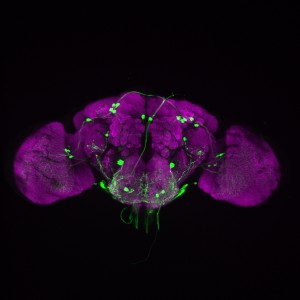
A mounted image entitled “The brain of a fruit fly, Drosophila melanogaster”, supplied by Dr. Gordon, was given away as the door prize to a member of the audience.
The LSI Café Scientifique is co-sponsored by the Life Sciences Institute (LSI), Michael Smith Foundation for Health Research (MSFHR), Faculty of Medicine Research Office, Faculty of Science, the Leica Corporation, the microscope company Systems for Research and Café Perugia (UBC Food Services).
The next Café Scientific that will continue the “Seeing is Believing” series will take place in spring 2012.
To view more pictures from the event, please visit our facebook page.

